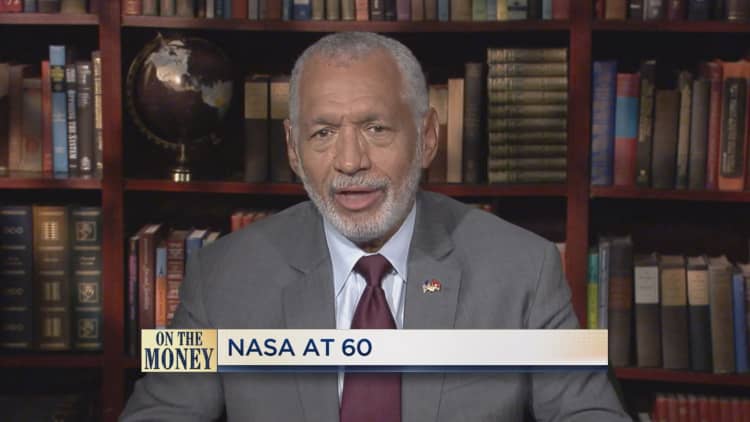
On Monday, NASA turns 60. For more than 20 of those, Charles Bolden has been a major part of the space agency.
From 1980 to 1994, he was an astronaut on four space shuttle missions: Two as pilot and two as commander. Then, he led the agency from 2009 to 2017, serving as NASA Administrator during the Obama Administration.
"For me, it's a tremendous birthday to be celebrating, sixty years," he tells CNBC's On The Money in a recent interview. "Six decades of NASA being the organization that serves the nation in four areas, human space flight, science, aeronautics and technology."
While Bolden was NASA Administrator, a stated goal was to land humans on Mars by the mid-2030's. He told CNBC that the space agency appears " on target to do that."
But now, a return trip of astronauts to the Moon will come before any human arrival on Mars. A number of space experts think a new lunar mission could prove instructive before making a journey to the red planet.
Bolden explained that the Trump Administration and current NASA leadership has "taken on the challenge of trying to put humans back on the surface on the moon which I think is important. It's not essential to putting humans on Mars, but I think it would be a very big step as long as we do it in the right way."
That way, he added, the government can "capitalize on the development of the commercial space sector as well as our international partners to help us get humans back on the surface of the Moon, while NASA leads the way with our international partners and entrepreneurs in getting humans to Mars."
My favorite 'Martian'
In the 2015 film, "The Martian," Matt Damon was a stranded astronaut who needed to figure out how to grow his own food in a greenhouse to survive on the red planet.
Bolden says the fictional story contained a lot of factual accuracy.
"In talking to the director and producer and others, it was really their intent to try to be as close to fact as possible. "
"Much of what you saw in 'The Martian' has either already happened or is in the process of happening," Bolden explained.
"An example would be taking carbon dioxide from the Martian atmosphere. We have a mission called Mars 2020 that's going to land on Mars in that year and it will actually be exactly that," he added. "Take carbon dioxide from the Martian atmosphere, dissociate it so we get oxygen we can breathe and oxygen we can use in propulsion systems."
Back on earth, private space companies like SpaceX to Blue Origin and Virgin Galactic are in a race to take passengers beyond the earth's atmosphere for space tourism. Bolden supports those endeavors.
Although he's logged more than 680 hours in space, the 72 year-old veteran astronaut says he's willing to blast off again.
"I think it's an awesome thing," Bolden told CNBC. "I would go up in a heartbeat."



